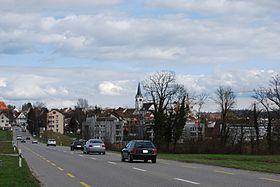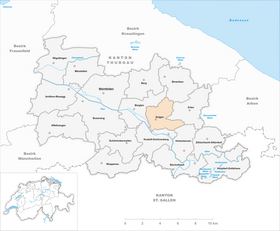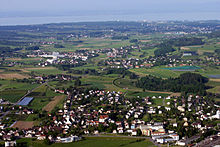Sulgen TG
| TG is the abbreviation for the canton of Thurgau in Switzerland and is used to avoid confusion with other entries of the name Sulgen . |
| Sulgen | |
|---|---|
| Country: |
|
| Canton : | Thurgau (TG) |
| District : | Weinfelden |
| Postal code : | 8583 |
| BFS no. : | 4506 (Political Community) |
| former BFS no .: | 4510 (local parish) |
| UN / LOCODE : | CH SGE |
| Coordinates : | 731367 / 266194 |
| Height : | 460 m above sea level M. |
| Area : | 9.12 km² (Polish municipality) 3.40 km² (local municipality) |
| Residents: | 3869 (December 31, 2018) |
| Population density : | 424 inhabitants per km² |
| Website: | www.www.sulgen.ch |
|
Sulgen TG |
|
| map | |
Sulgen is a municipality in the Weinfelden district of the Swiss canton of Thurgau . It consists of the core settlement Sulgen and the localities Götighofen and Donzhausen as well as Hessenreuti and other hamlets .
The former municipal community Sulgen consisted of the local communities Götighofen, Kradolf , Sulgen, Riedt (until 1994) and Bleiken (until 1964) from 1803 to 1995 .
geography

The village, located on a moraine at the transition from the Thur to the Aachtal, owes its development to the good traffic situation. Here the most important east-west connection through the canton from Frauenfeld to Romanshorn crosses with the road from Konstanz to Gossau SG . In addition, the Bischofszellerbahn branches off the Thurtal line in Sulgen .
Sulgen borders the communities of Birwinken , Erlen , Hohentannen , Kradolf-Schönenberg and Bürglen .
history

Sulgen was first mentioned in 806 as Sulaga . In Sulgen, Hessenreuti and Mühlebach near Amriswil, the St. Pelagiusstift Bischofszell owned goods in the Middle Ages ( opening in 1472 ). The rule of Bürglen and the Kreuzlingen monastery shared the lower court rights in Sulgen until 1798 . Sulgen was a major parish that included Sulgen until 1809, Andwil , until 1851 Berg TG , until 1809 Bürglen, until 1992 Erlen, Guntershausen bei Berg (since 1995 with Berg) and until 1604 Neukirch an der Thur .
The St. Pelagiusstift initially only owned the collage . In 1269 the Bishop of Constance allowed him to collect taxes for his own needs, and in 1359 Sulgen was incorporated into the monastery. After the Reformation in 1529, the fair was again permitted in 1535. From then on the church was used simultaneously , from 1712 to 1961 equally . In 1851 the collature came to the parish. Between 1959 and 1961 the Catholic church was built by Ernst Brantschen.
In Sulgen, grain was grown in three tents and flax was grown. In the 19th century the transition to field grass, cattle and dairy farming and fruit growing took place. In 1860 a cheese dairy was opened. From 1650 linen was produced; cotton processing followed later, calico weaving around 1810 , embroidery from 1850 and ship embroidery in 1890, which was operated until 1930. Sulgen grew considerably after it had received a station on the Winterthur – Romanshorn railway line in 1855 and became the starting point for the line to Gossau in 1876 . From 1919 to 1923 there was a milk powder factory, which was newly founded in 1930 and taken over by Hochdorf Nutritec in 2003 ; in 2010 it employed 108 people. In 1933, the Greuter knitting mill was launched and in 1970 it changed its name to Greuter-Jersey. From 2008 it was owned by E. Schellenberg Textildruck and has not been producing in Sulgen since then. In 1980, medical technology found its way into Sauter AG, which has been owned by Belimed since 1999 . Other resident companies in 2011 were Sidag (Sicilia lemon juice), Erich Keller AG (office furnishings) and Niggli AG. In 2005, 53% of the workforce were employed in the second economic sector and 40% in the service sector.
In 1964, the former local community Bleiken was incorporated into the local community Sulgen. The political community was formed in stages from 1995 to 1996: Since January 1, 1995, the district of Uerenbohl, which has been separated from the local community of Opfershofen, has belonged to Sulgen. Also in 1995, the local community of Riedt was separated from the municipal community of Sulgen and added to the community of Erlen . The local communities Donzhausen and Hessenreuti had belonged to the municipal municipality Bürglen before 1995, afterwards they joined the municipal municipality Sulgen and in 1996 merged with the local municipalities Götighofen and Sulgen and the municipal municipality Sulgen to form the unitary municipality Sulgen. At the same time, the local community of Kradolf, which had been separated from the municipal community of Sulgen, merged to form the community of Kradolf-Schönenberg .
→ See also the history sections in the articles Bleiken TG , Donzhausen , Götighofen and Hessenreuti
coat of arms
Blazon : split by yellow with a lion and red with a cross in alternating colors.
The coat of arms reflects the rulership, in that the village belonged partly to the Bürglen rulership and partly to the Kreuzlingen monastery. The colors symbolize that the parish of Sulgen belongs to the Pelagi peninsula in Bischofszell.
population
 |
| 1850 | 1870 | 1900 | 1950 | 1990 | 2000 | 2010 | 2018 | |
|---|---|---|---|---|---|---|---|---|
| Political community | 3422 | 3397 | 3842 | |||||
| Municipal parish | 1185 | 1155 | 1866 | 3054 | 4383 | |||
| Local parish | 416 | 616 | 1212 | 2552 | ||||
| source | ||||||||
Of the total of 3842 inhabitants in the municipality of Sulgen in 2018, 989 or 25.7% were foreign nationals. 1,269 (33.0%) were Protestant Reformed and 1,100 (28.6%) were Roman Catholic. The village of Sulgen had 3355 residents at that time.
economy
In 2016, Sulgen offered work for 1805 people (converted to full-time positions). Of these, 4.0% worked in agriculture and forestry, 62.6% in industry, trade and construction and 33.4% in the service sector.
Attractions
- Reformed Church, 15. – 19. Century
- Catholic Church of St. Peter and Paul, built 1959–61, inspired by Le Corbusier; Architects: Ernest Brantschen and Alfons Weisser , who had previously built the Bruder-Klaus-Kirche Winkeln .
People (selection)
- Max Küchler (* 1944), Roman Catholic theologian
Web links
Individual evidence
- ↑ a b Thurgau in figures 2019 . On the website of the Statistical Office of the Canton of Thurgau (PDF file; 1.8 MB), accessed on April 28, 2020.
- ↑ Swiss land use statistics. Completed on July 1, 1912. Published by the Federal Statistical Bureau. ( Memento from April 12, 2016 in the Internet Archive )
- ↑ Permanent and non-permanent resident population by year, canton, district, municipality, population type and gender (permanent resident population). In: bfs. admin.ch . Federal Statistical Office (FSO), August 31, 2019, accessed on December 22, 2019 .
- ↑ a b Localities and their resident population. Edition 2019 . On the website of the Statistical Office of the Canton of Thurgau (Excel table; 0.1 MB), accessed on April 28, 2020.
-
↑ a b c d e Erich Trösch: Sulgen. In: Historical Lexicon of Switzerland .
These sections are largely based on the entry in the Historical Lexicon of Switzerland (HLS), which, according to the HLS's usage information, is under the Creative Commons license - Attribution - Share under the same conditions 4.0 International (CC BY-SA 4.0). - ↑ a b c population development of the municipalities. Canton Thurgau, 1850–2000 and resident population of the municipalities and change from the previous year. Canton of Thurgau, 1990–2018. On the website of the Statistical Office of the Canton of Thurgau (Excel tables; 0.1 MB each), accessed on April 28, 2020.
- ↑ a b municipal coat of arms . On the website of the State Archives of the Canton of Thurgau, accessed on December 8, 2019
- ^ André Salathé, Cornelia Stähli, Marcus Casutt: The churches of Sulgen. (Swiss Art Guide, No. 752, Series 76). Ed. Society for Swiss Art History GSK. Bern 2004, ISBN 978-3-85782-752-5 .

















